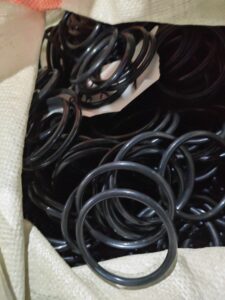Table of Contents
ToggleWhere Is an O-Ring Used?
O-rings are among the most ubiquitous sealing solutions in engineering, offering simplicity, reliability, and adaptability across industries. Their donut-shaped geometry and diverse material options enable them to seal static and dynamic interfaces in environments ranging from extreme heat to cryogenic cold. Below is a detailed exploration of their applications in critical sectors:

1. Automotive Industry
O-rings are integral to modern vehicles, with hundreds used in subsystems:
- Engine Systems:
- Valve cover gaskets, crankshaft seals, and camshaft seals prevent oil leaks.
- Turbocharger seals endure high heat and exhaust gases.
- Fuel Systems:
- Fuel injectors, pumps, and connectors resist gasoline and diesel exposure.
- Transmission & Drivetrain:
- Automatic transmission fluid (ATF) lines and gearbox seals.
- Cooling Systems:
- Radiator hoses, water pump seals, and thermostat housings.
- Braking Systems:
- Hydraulic brake lines and master cylinders seal high-pressure brake fluid.
- Air Conditioning:
- Refrigerant line seals and compressor O-rings.
Material Highlight: Nitrile rubber (NBR) dominates due to oil resistance and flexibility at low temperatures.
2. Aerospace & Aviation
O-rings ensure safety and performance in extreme conditions:
- Hydraulic Systems:
- Landing gear actuators and flight control systems handle hydraulic fluid under extreme pressure.
- Fuel Systems:
- Jet engine fuel valves and rocket propulsion systems withstand cryogenic fuels and high temperatures.
- Environmental Control:
- Cabin pressure seals and oxygen system connectors.
- Engine Components:
- Turbine blade seals and combustion chamber gaskets.
Material Highlight: High-performance elastomers like FKM (Viton®) and FFKM offer thermal stability and low gas permeability.
3. Industrial Machinery
O-rings maintain efficiency in demanding industrial environments:
- Hydraulics & Pneumatics:
- Pumps, cylinders, and valves seal oil, air, or gas under pressure.
- Chemical Processing:
- Reactors and pipelines resist acids, solvents, and corrosive chemicals.
- High-Pressure Equipment:
- Compressors, steam valves, and pressure vessels.
- Oil & Gas:
- Drilling equipment and offshore rigs endure harsh, corrosive environments.
Material Highlight: EPDM for steam resistance, PTFE for chemical inertness.
4. Plumbing & HVAC
O-rings prevent leaks in residential and commercial systems:
- Water Systems:
- Pipe joints, faucets, and water heaters ensure leak-free potable water.
- Gas Lines:
- Natural gas and propane connectors provide gas-tight seals.
- Refrigeration:
- AC units and chillers seal refrigerants like Freon.
Material Highlight: Silicone for temperature flexibility, EPDM for hot water resistance.
5. Medical Devices
O-rings meet stringent biocompatibility standards:
- Diagnostic Equipment:
- MRI machines and blood analyzers ensure sterile fluid handling.
- Surgical Tools:
- Endoscopes and dialysis machines use biocompatible seals.
- Pharmaceutical Manufacturing:
- Sterile processing equipment complies with FDA regulations.
Material Highlight: Platinum-cured silicone and FFKM for medical-grade compatibility.
6. Consumer Products
O-rings enhance durability in everyday items:
- Appliances:
- Dishwashers and washing machines seal water and detergent lines.
- Electronics:
- Waterproof connectors and underwater camera housings.
- Outdoor Gear:
- Scuba regulators and waterproof flashlights.
7. Energy & Power Generation
O-rings support critical infrastructure:
- Nuclear Plants:
- Reactor coolant systems use radiation-resistant materials.
- Wind Turbines:
- Hydraulic pitch control systems.
- Solar Panels:
- Fluid-carrying components in concentrated solar systems.
8. Marine & Offshore
O-rings combat saltwater corrosion and pressure:
- Ship Engines:
- Seawater cooling systems and propeller shaft seals.
- Subsea Equipment:
- Underwater robotics and oil risers operate in high-pressure environments.
Application Modes: Static vs. Dynamic Seals
- Static Seals:
- Used in fixed joints (e.g., pipe flanges, battery enclosures). Compression fills gaps to prevent leaks.
- Dynamic Seals:
- Accommodate motion in pistons, rotating shafts, and pumps. Design considerations include abrasion resistance and heat management.
Material Selection Guide
| Environment | Preferred Material |
| High Heat/Chemicals | Viton® (FKM), FFKM |
| Low Temperatures | Silicone (VMQ), Low-Temp FKM |
| Oil/Fuel Exposure | Nitrile (NBR), HNBR |
| Water/Steam | EPDM Rubber |
| Biocompatibility | Platinum-Cured Silicone, FFKM |
| Abrasion Resistance | Polyurethane (PU) |
Why O-Rings Dominate Sealing Solutions
- Simplicity: Easy installation and replacement.
- Cost-Effectiveness: Lower production costs than complex seals.
- Versatility: Adapt to static/dynamic roles, pressures from vacuum to 5,000+ psi.
- Reliability: Self-energizing design enhances sealing under pressure.
Conclusion
From automotive engines and aerospace hydraulics to medical devices and household appliances, O-rings are indispensable for leak-free performance. Their material adaptability—whether NBR for cost-effective oil resistance or FFKM for extreme conditions—makes them a cornerstone of modern engineering. By aligning material properties with operational demands, industries achieve safety, efficiency, and longevity in even the harshest environments.
O-rings exemplify the power of simplicity: a single, precisely engineered loop ensures the integrity of systems that power our world.



Leave A Comment